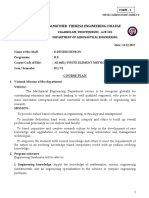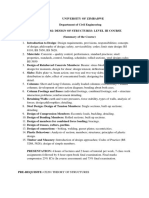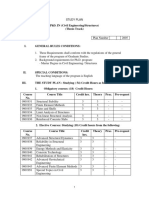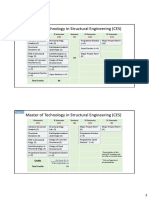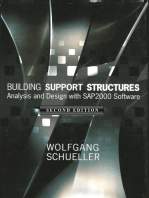0 ratings0% found this document useful (0 votes)
294 viewsSyl Lab Structural Analysis 2
This syllabus outlines a structural analysis course offered at the National University of Engineering. The course provides students with fundamental principles of matrix analysis of structures and its application to bar structures. Over the course of the semester, students will learn to analyze reticulated and portico-type structures, use specialized software, and interpret structural behavior results. Assessment includes midterm and final exams, quizzes, and design project reports.
Uploaded by
Christian Alcedo SantiCopyright
© © All Rights Reserved
Available Formats
Download as PDF, TXT or read online on Scribd
0 ratings0% found this document useful (0 votes)
294 viewsSyl Lab Structural Analysis 2
This syllabus outlines a structural analysis course offered at the National University of Engineering. The course provides students with fundamental principles of matrix analysis of structures and its application to bar structures. Over the course of the semester, students will learn to analyze reticulated and portico-type structures, use specialized software, and interpret structural behavior results. Assessment includes midterm and final exams, quizzes, and design project reports.
Uploaded by
Christian Alcedo SantiCopyright
© © All Rights Reserved
Available Formats
Download as PDF, TXT or read online on Scribd
You are on page 1/ 3
1
NATIONAL UNIVERSITY OF ENGINEERING
COLLEGE OF CIVIL ENGINEERING
CIVIL ENGINEERING PROGRAM
SYLLABUS - STRUCTURAL ANALYSIS II
I. GENERAL INFORMATION
CODE : EC213
SEMESTER : 10
CREDITS : 4
HOURS PER WEEK : 6 (Theory Practice)
PREREQUISITES : EC211 Structural Analysis I
CONDITION : Elective
INSTRUCTOR : Hugo Scaletti
INSTRUCTOR E-MAIL : scaletti@alum.mit.edu
II. COURSE DESCRIPTION
This course provides students with fundamental principles of the Matrix Analysis of structures and
its application to bar structures. Its general objective is the understanding of the concepts on which
computational techniques used in structural analysis are based and their application through
manual procedures using calculators and student versions of commercial programs as well as the
analysis of the results obtained.
III. COURSE OUTCOMES
1. Apply methods and techniques common in Civil Engineering for formulating and solving
problems of the specialty.
2. Use specialized software to perform his/her work.
3. Interpret results of the structures behavior from the laws which determine them.
4. Mathematically represent the structural analysis of civil engineering problems, and carry out
the respective modeling and analysis.
5. Analyze and design reticulated structures.
6. Analyze and design portico-type structures.
IV. LEARNING UNITS
1. ANALYSIS OF RETICULATEDSTRUCTURES
Plane and spatial reticulated structures / Assumptions and simplifying assumptions / Rigidity of 2D
and 3D bi-articulated bars / Analysis of reticulated structures with concentrated loads /
Temperature increments / Initial deformations / Algorithms and programs for analyzing reticulated
2. ANLYSIS OF PORTICO-TYPE STRUCTURES
Rigidity and flexibility of 2D beam-column elements / Shear deformation / Translation and rotation
of reference system / Consideration for distributed forces / Genera 3D case / Simplifying
hypothesis.
2
3. ADDITIONAL TOPICS IN THE ANALYSIS OF PORTICO-TYPE STRUCTURES
Portico-type structures with plates / Rigidity of elements with rigid arms / Embedded forces /
Comparison of results with different hypothesis / Static and dynamic considerations / Elements with
articulated borders / Substructures / Elements with varying section and/or curve axis.
4. SEISMIC ANALYSIS WITH EQUIVALENT STATIC FORCES
Lateral rigidity of a leveled portico / Approximations for modeling / Close coupling modeling / Wall
lateral rigidity / Seismic analysis with tridimensional models / Rigid diaphragms / Comparison of
results with different hypothesis.
5. INTRODUCTION TO FINITE ELEMENTS
Principle of virtual work / Potential energy / Rigidity and statically equivalent forces / Simple finite
elements / Consistency, continuity and convergence / Iso-parametric elements / Practical
considerations / Analysis of slaps with transversal loads.
6. INTRODUCTION TO NONLINEAR ANALYSIS
Nonlinear behavior, analysis and design / Geometric nonlinearities / Tensed structures / Moments
magnification / Hypothesis of plastic patella / Seismic isolators and viscous dampers.
VI. METHODOLOGY
The course is carried out in theory and practice sessions, using active methods in the learning and
teaching process, encouraging students participation. The instructor exposes and gives examples
to complement students activities, using the available audiovisual aids. Students complete design
projects.
VII. EVALUATION FORMULA
The average grade PF is calculated as follows:
PF = 0.33 EP + 0.33 EF + 0.16 PP + 0.17 TE
EP: Mid-Term Exam EF: Final Exam
PP: Average of three quizzes TE: Average of four design project reports
VIII. BIBLIOGRAPHY
1. MC GUIRE, William, GALLAGHER, Richard y ZIEMIAN, Ronald
Matrix Structural Analysis
J ohn Wiley and Sons, N.Y., 2000
2. TENA, Arturo
Structures Analysis Using Matrix Methods
Limusa Editorial, Mxico, 2004
3. JAVIER PIQU AND HUGO CALETTI
Building Seismic Analysis
CIP Chapter of Civil Engineering. Lima, 1991
3
IX. COURSE CONTRIBUTIONS TO STUDENT OUTCOMES ATTAINMENT
Course contributions to Student Outcomes are shown in the following table:
K =Key R =Related Empty box =Does not apply
Outcome Contribution
Engineering
Design
Design civil works satisfying requirements and needs as well as
given constraints and limitations.
K
Problem solving
Identify, formulate and solve engineering problems properly
using the methods, techniques and tools of civil engineering.
K
Sciences
Application
Apply the knowledge and skills of mathematics, sciences and
engineering to solve civil engineering problems.
K
Experimentation
Conceive and conduct experiments, analyze data and interpret
results
Modern
Engineering
Use and apply techniques, methods and tools of modern
engineering necessary for the practice of civil engineering.
R
Engineering
Impact
Understand the impact of engineering solutions on people and
society in local and global contexts.
R
Project
Management
Plan and manage civil engineering projects taking into account
efficiency and productivity criteria.
R
Environmental
Appraisal
Takes into account the importance of preserving and improving
the environment in the development of their personal and
professional activities.
R
Lifelong
Learning
Recognize the need to keep their knowledge and skills up to
date according to advances of civil engineering and engage in
lifelong learning.
R
Contemporary
Issues
Know and analyze relevant contemporary issues in local,
national and global contexts.
R
Ethics and
Professional
Responsibility
Evaluate their decisions and actions from a moral perspective
and assume responsibility for the executed projects.
R
Communication
Communicate clearly and effectively in oral, written and
graphical formats, interacting with different types of audiences.
K
Teamworking
Appraise the importance of teamworking and participate
actively and effectively in multidisciplinary teams.
K
You might also like
- Colegio de La Purisima Concepcion Ce ElectNo ratings yetColegio de La Purisima Concepcion Ce Elect9 pages
- Course Syllabus in EARTHQUAKE ENGINEERINGNo ratings yetCourse Syllabus in EARTHQUAKE ENGINEERING9 pages
- Colegio de La Purisima Concepcion Ce ElectNo ratings yetColegio de La Purisima Concepcion Ce Elect11 pages
- Curriculum & Syllabus: Civil EngineeringNo ratings yetCurriculum & Syllabus: Civil Engineering43 pages
- Computer Aided Analysis and Design (CE-411)No ratings yetComputer Aided Analysis and Design (CE-411)7 pages
- ST - Mother Theresa Engineering College: Course PlanNo ratings yetST - Mother Theresa Engineering College: Course Plan8 pages
- 2_M.Tech_Engineering_Structures-Curriculum-new-2024-25_2024-7-19-16-29-20No ratings yet2_M.Tech_Engineering_Structures-Curriculum-new-2024-25_2024-7-19-16-29-2069 pages
- Department of Civil Engineering Ce 302: Design of Structures: Level Iii Course (Summary of The Course)No ratings yetDepartment of Civil Engineering Ce 302: Design of Structures: Level Iii Course (Summary of The Course)6 pages
- PHD Civil Engineering Structures - Thesis TrackNo ratings yetPHD Civil Engineering Structures - Thesis Track4 pages
- Department of Civil Engineering: Course Structure and SyllabusNo ratings yetDepartment of Civil Engineering: Course Structure and Syllabus19 pages
- Sesimic and FE - Undergrad Handbook-2021-22-Ver 1No ratings yetSesimic and FE - Undergrad Handbook-2021-22-Ver 112 pages
- Structural Engg 2022 Regulation- CurriculumNo ratings yetStructural Engg 2022 Regulation- Curriculum87 pages
- Civil Engineering: Computer Aided Structural EngineeringNo ratings yetCivil Engineering: Computer Aided Structural Engineering38 pages
- Master of Technology in Structural Engineering (CES) : I Semester II Semester Summer III Semester IV SemesterNo ratings yetMaster of Technology in Structural Engineering (CES) : I Semester II Semester Summer III Semester IV Semester132 pages
- COURSE-SYLLABUS-in-CE-PC-313STRUCTURAL-THEORYNo ratings yetCOURSE-SYLLABUS-in-CE-PC-313STRUCTURAL-THEORY6 pages
- Design of Reinforces Concrete StructuresNo ratings yetDesign of Reinforces Concrete Structures21 pages
- List of Modules Offered in Academic Year 2008/2009: Department of Civil EngineeringNo ratings yetList of Modules Offered in Academic Year 2008/2009: Department of Civil Engineering20 pages
- 04 - Structural Engineering and Construction Management0% (1)04 - Structural Engineering and Construction Management45 pages
- CE 360 Structural Analysis Course SyllabiNo ratings yetCE 360 Structural Analysis Course Syllabi3 pages
- ME SE Syllabus Obj Outcome PO PEO 12-09-16 Rev1No ratings yetME SE Syllabus Obj Outcome PO PEO 12-09-16 Rev176 pages
- Engineering_Structures_2023-10-26-16-15-57No ratings yetEngineering_Structures_2023-10-26-16-15-5768 pages
- Civil Engg. Anna University TVL SyllabusNo ratings yetCivil Engg. Anna University TVL Syllabus103 pages
- Building Support Structures, 2nd Ed., Analysis and Design with SAP2000 SoftwareFrom EverandBuilding Support Structures, 2nd Ed., Analysis and Design with SAP2000 Software4.5/5 (15)
- Training Engineers for InnovationFrom EverandTraining Engineers for InnovationDenis LemaîtreNo ratings yet
- Building Professionals Facing the Energy Efficiency ChallengeFrom EverandBuilding Professionals Facing the Energy Efficiency ChallengeNo ratings yet
- Melissa Dell - Persistent Effects Mita (MIT)No ratings yetMelissa Dell - Persistent Effects Mita (MIT)43 pages
- Confined Masonry vs. RC Frame With Masonry InfillNo ratings yetConfined Masonry vs. RC Frame With Masonry Infill14 pages
- Influence Line For Girder: - Forces Apply To The GirderNo ratings yetInfluence Line For Girder: - Forces Apply To The Girder61 pages












